

汽车中的真空管荧光显示器(VFD)参考设计,Vacuum F
汽车电子
描述
Vacuum Fluorescent Display (VFD) Reference Design for Automotive Applications
Abstract: This article describes a vacuum fluorescent display (VFD) and some ideal applications for the technology. The reference design then shows how to use a MAX15005 power-supply controller in a flyback topology to obtain multiple output voltages for a vacuum fluorescent display.
Introduction
This reference design shows a solution for obtaining the drive voltage required for a vacuum fluorescent display (VFD) power supply in automotive applications. The design includes the complete schematic, and presents the bill of materials (BOM), load/line regulation measurements, and test results.
VFD Basics
A vacuum fluorescent display (VFD) is a type of display used commonly on consumer-electronics equipment such as video cassette recorders, car radios, and microwave ovens. Unlike liquid crystal displays (LCDs), a VFD emits a very bright light with clear contrast and can easily support display elements of various colors. The technology is related to both the cathode ray tube and the nixie tube. Unlike LCDs, however, most VFDs continue to function normally in subzero temperatures, making them ideal for outdoor devices in cold climates.
The VFD is composed of three basic electrodes—the cathode filaments, anodes (phosphor), and grids—under a high-vacuum condition in a glass envelope. The cathode consists of fine tungsten wires, coated by alkaline earth metal oxides which emit electrons. The grids are a thin metal mesh, which controls and diffuses electrons emitted from the cathode. The anodes are conductive electrodes on which the phosphor is printed to indicate characters, icons, or symbols. Electrons emitted from the cathode are accelerated with positive potential applied to both grid and anode; upon collision with the anode the electrons excite the phosphor to emit light. The desired illuminated patterns can be achieved by controlling the positive or negative potentials on each grid and anode. The anode and grid require a DC-regulated voltage to avoid flickering of the display. For driving large VFDs, the cathode requires AC drive to prevent luminance slant, i.e., the difference in brightness from one side of the display to the other. A frequency range of 20kHz to 200kHz is recommended to avoid audible noise and flicker.
Design Specifications and Setup
This reference design features the MAX15005 power-supply controller optimized for automotive and VFD applications. The application circuit is designed to meet the following specifications:
- VIN: 9V to 16V continuous, 5.5V to 40V transient
- VANODE: 77VDC ±10% at 18mA (typ), 58mA (max)
- VGRID: 55VDC ±10% at 14mA (typ), 41mA (max)
- VFILAMENT: 3.1VAC ±10% at 350mA (typ), 385mA (max)
- Output ripple: 77V: 1VP-P; 55V: 0.5VP-P
- Line regulation, VIN = 9V to 16V:
VANODE = ±3%
VGRID = ±3%
VFILAMENT = ±5%
- Load regulation: (see Line/Load Regulation Data section below)
- Switching frequency: 22kHz
- Temperature: -40°C to 125°C
The schematic for the above specifications is shown in Figure 1. In this design MAX15005A is used in the flyback configuration for obtaining three output voltages. 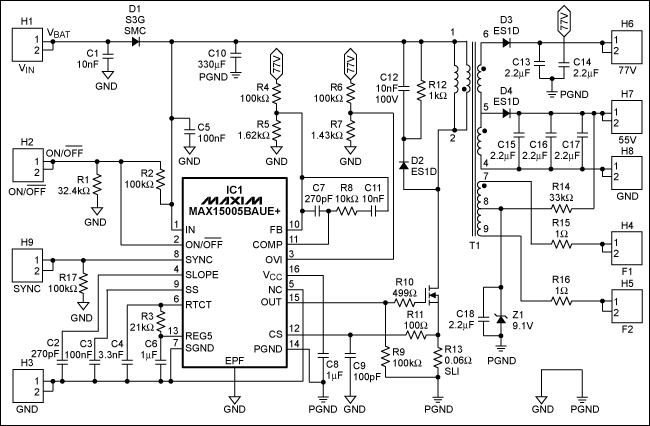
Figure 1. Schematic of the MAX15005B flyback converter for FSW = 22kHz.
The bill of materials (BOM) for this reference design is given in Table 1.
Table 1. Bill of Materials for VFD Reference Design
| Designator | Value | Description | Part Number | Footprint | Manufacturer | Quantity |
| C1, C11, C12 | 10nF, 100V | Capacitor | C2012X7R2A103K | 0805 | TDK® | 3 |
| C2, C7 | 270pF, 100V | Capacitor | GRM188R72A271KA01D | 0805 | Murata® | 2 |
| C3, C5 | 100nF, 100V | Capacitor | C2012X7R2A104K | 0805 | TDK | 2 |
| C4 | 3.3nF, 25V | Capacitor | 08053A332FAT2A | 0805 | AVX® Corporation | 1 |
| C6, C8 | 1µF, 50V | Capacitor | C3216X7R1H105K | 1206 | TDK | 2 |
| C9 | 100pF, 100V | Capacitor | GRM2165C2A101JA01D | 0805 | Murata | 1 |
| C10 | 330µF, 35V | Capacitor | – | SMD | TDK | 1 |
| C13, C14, C15, C16, C17, C18 | 2.2µF, 100V | Capacitor | GRM32ER72A225KA35L | 1210 | Murata | 6 |
| D1 | 3A, 400V | Diode | S3G | SMC | Vishay® | 1 |
| D2, D3, D4 | 1A, 200V | Diode | ES1D | SMA | Vishay | 3 |
| Q1 | 11A, 55V | n-FET | BUK92150-55A | – | NXP® | 1 |
| R1 | 32.4kΩ | Resistor | SMD, 5%, 0.125W | 0805 | KOA | 1 |
| R2, R9, R17 | 100kΩ | Resistor | SMD, 5%, 0.125W | 0805 | KOA | 3 |
| R3 | 21kΩ | Resistor | SMD, 1%, 0.125W | 0805 | KOA | 1 |
| R4, R6 | 100kΩ | Resistor | SMD, 1%, 0.250W | 1206 | KOA | 2 |
| R5 | 1.62kΩ | Resistor | SMD, 1%, 0.125W | 0805 | KOA | 1 |
| R7 | 1.43kΩ | Resistor | SMD, 1%, 0.125W | 0805 | KOA | 1 |
| R8 | 10kΩ | Resistor | SMD, 5%, 0.125W | 0805 | KOA | 1 |
| R10 | 499Ω | Resistor | SMD, 1%, 0.125W | 0805 | KOA | 1 |
| R11 | 100Ω | Resistor | SMD, 5%, 0.125W | 0805 | KOA | 1 |
| R12 | 1kΩ | Resistor | SMD, 1%, 0.333W | 1210 | KOA | 1 |
| R13 | 0.06Ω | Resistor | SMD, 1%, SL1 | SL1 | KOA | 1 |
| R14 | 33kΩ | Resistor | SMD, 5%, 0.125W | 0805 | KOA | 1 |
| R15, R16 | 1.0Ω | Resistor | SMD, 1%, 0.250W | 1206 | KOA | 2 |
| T1 | 54µH | Transformer | DCT20EFD-UxxSOA5 | SMD | TDK | 1 |
| Z1 | 9.1V | Zener diode | 1SMB5924BT | SMB | Vishay | 1 |
| IC1 | MAX15005B | Boost controller | MAX15005BAUE+ | 16TSSOP | MAXIM® | 1 |
Waveform Measurements
The following test results were generated from the board built for evaluating the circuit.
Test conditions: VIN = 14V; RANODE = 3.3kΩ; RGRID = 3.3kΩ; RFILAMENT = 8Ω.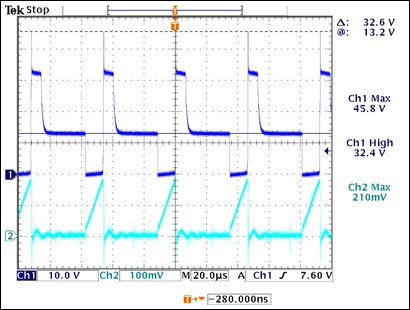
Ch1: MOSFET Q1 drain voltage (VDRAIN); Ch2: current-sense voltage across R13 (VISENSE).
Test conditions: VIN = 14V; RANODE = 3.3kΩ; RGRID = 3.3kΩ; RFILAMENT = 8Ω.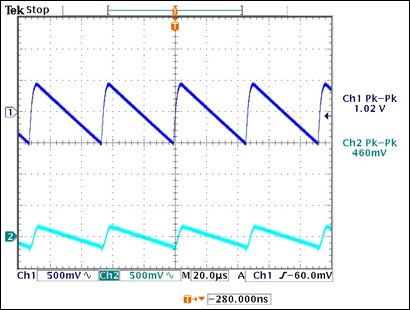
Ch1: anode output voltage ripple; Ch2: grid output voltage ripple.
Test conditions: VIN = 14V; RANODE = 3.3kΩ; RGRID = 3.3kΩ; RFILAMENT = 8Ω.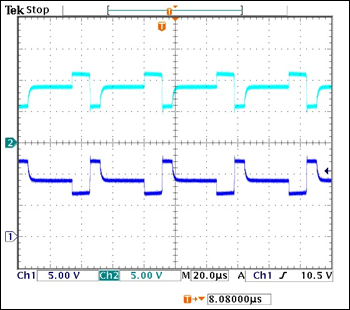
Ch1: filament positive node voltage (VF1); Ch2: filament negative node voltage (VF2).
Test conditions: VIN = 14V; RANODE = 3.3kΩ; RGRID = 3.3kΩ; RFILAMENT = 8Ω.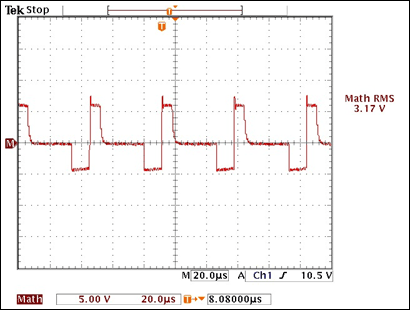
M: effective filament voltage (VF1 - VF2).
Line/Load Regulation Data
The following line/load regulation data was taken from the test board over the input voltage range and load.
| VIN | I77 (mA) | I55 (mA) | V77 (VDC) | V55 (VDC) | VF (VRMS) |
| 9.0 | 7.7 | 5.5 | 77.0 | 55.2 | 2.41 |
| 7.7 | 16.7 | 77.0 | 55.0 | 2.64 | |
| 7.7 | 44.0 | 77.0 | 54.8 | 3.03 | |
| 23.0 | 5.5 | 77.0 | 55.4 | 2.82 | |
| 23.0 | 16.7 | 77.0 | 55.2 | 2.97 | |
| 23.0 | 44.0 | 77.0 | 55.0 | 3.24 | |
| 61.6 | 5.5 | 77.0 | 55.8 | 3.35 | |
| 61.6 | 16.7 | 77.0 | 55.6 | 3.43 | |
| 61.6 | 44.0 | 77.0 | 55.4 | 3.62 | |
| 14.0 | 7.7 | 5.5 | 77.0 | 55.2 | 2.52 |
| 7.7 | 16.7 | 77.0 | 55.0 | 2.75 | |
| 7.7 | 44.0 | 77.0 | 54.8 | 3.14 | |
| 23.0 | 5.5 | 77.0 | 55.4 | 2.80 | |
| 23.0 | 16.7 | 77.0 | 55.2 | 3.08 | |
| 23.0 | 44.0 | 77.0 | 55.0 | 3.36 | |
| 61.6 | 5.5 | 77.0 | 55.8 | 3.50 | |
| 61.6 | 16.7 | 77.0 | 55.7 | 3.59 | |
| 61.6 | 44.0 | 77.0 | 55.4 | 3.79 | |
| 16.0 | 7.7 | 5.5 | 77.0 | 55.2 | 2.63 |
| 7.7 | 16.7 | 77.0 | 55.0 | 2.86 | |
| 7.7 | 44.0 | 77.0 | 54.8 | 3.25 | |
| 23.0 | 5.5 | 77.0 | 55.4 | 3.04 | |
| 23.0 | 16.7 | 77.0 | 55.2 | 3.20 | |
| 23.0 | 44.0 | 77.0 | 55.0 | 3.49 | |
| 61.6 | 5.5 | 77.0 | 54.8 | 3.25 | |
| 61.6 | 16.7 | 77.0 | 55.0 | 3.49 | |
| 61.6 | 44.0 | 77.0 | 55.4 | 3.92 |
Conclusion
This application note presents a power-supply reference design for driving a typical vacuum fluorescent display in an automotive application. The design was built to the specifications presented here. The design was then tested. The circuit schematic, BOM, and typical waveforms have been presented.
- 相关推荐
- 热点推荐
- Display
-
谁终结了真空管的时代?2025-02-24 3111
-
DIY真空管测试仪2022-08-10 983
-
怎样去设计一种真空管荧光显示器(VFD)?2021-05-17 2134
-
汽车中的真空管荧光显示器 (VFD)参考设计2010-12-29 495
-
如何改善真空管音质与使用寿命2010-11-01 1783
-
真空管荧光显示器(VFD)供电电源的解决方案2010-10-14 7401
-
VFD真空荧光显示屏应用指南2010-09-03 2030
-
真空管特性规格名词解释2010-04-03 4322
-
VFD(荧光管显示),VFD(荧光管显示)是什么意思2010-03-26 8781
-
VFD屏显2009-12-28 1239
-
太阳能热管真空管集热器2009-11-14 3769
-
汽车中的真空管荧光显示器(VFD)参考设计2009-10-30 904
-
真空管的应用2009-01-12 1226
-
真空管的工作原理2008-02-28 9638
全部0条评论

快来发表一下你的评论吧 !

